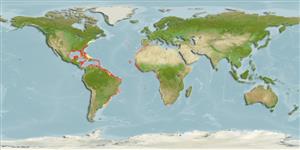>
Tetraodontiformes (Puffers and filefishes) >
Ostraciidae (Boxfishes)
Etymology: Acanthostracion: Greek, akantha = thorn + Greek, ostrakon = shell (Ref. 45335); quadricornis: Specific name refers to the 2 pairs of horns ('quadricornis' = 4 horns), in front of the eyes and a second pair at the lower rear corners of the cuirass..
More on author: Linnaeus.
Environment: milieu / climate zone / depth range / distribution range
Écologie
marin récifal; profondeur 1 - 80 m (Ref. 26938), usually 10 - 30 m (Ref. 40849). Subtropical; 43°N - 39°S, 100°W - 26°E
Atlantic Ocean: in tropical and temperate waters (Ref. 3696). Western Atlantic: Massachusetts (USA), Bermuda, and northern Gulf of Mexico to southeastern Brazil. Reported from tip of South Africa.
Length at first maturity / Taille / Poids / Âge
Maturity: Lm 22.2, range 17 - ? cm
Max length : 55.0 cm TL mâle / non sexé; (Ref. 6937); common length : 20.0 cm TL mâle / non sexé; (Ref. 3696)
Épines dorsales (Total): 0; Rayons mous dorsaux (Total): 10; Épines anales 0; Rayons mous anaux: 10. Dark markings on head and body; parallel bands on cheek. Pair of prominent spines projecting from in front of eyes suggests cow horns. Second pair of spines at lower rear corners of cuirass (Ref. 26938). Body deep, covered with hexagonal dermal plates (Ref. 37521).
Found in shallow water down to about 80 m, mainly in seagrass beds (Ref. 3696). Feeds on sessile invertebrates such as tunicates, gorgonians and anemones, as well as on slow-moving crustaceans, sponges (Ref. 3696), hermit crabs and marine plants (Ref. 13442). Oviparous (Ref. 205). Considered an excellent food fish; marketed fresh (Ref. 3696).
Smith, M.M., 1986. Ostraciidae. p. 890-893. In M.M. Smith and P.C. Heemstra (eds.) Smiths' sea fishes. Springer-Verlag, Berlin. (Ref. 3141)
Statut dans la liste rouge de l'IUCN (Ref. 130435)
Menace pour l'homme
Reports of ciguatera poisoning (Ref. 30303)
Utilisations par l'homme
Pêcheries: intérêt commercial mineur; Aquarium: Commercial
Plus d'informations
RéférencesAquacultureProfil d'aquacultureSouchesGénétiqueElectrophoresesHéritabilitéPathologiesTraitementNutrientsMass conversion
Outils
Articles particuliers
Télécharger en XML
Sources Internet
Estimates based on models
Preferred temperature (Ref.
123201): 22.3 - 28, mean 25.4 °C (based on 458 cells).
Phylogenetic diversity index (Ref.
82804): PD
50 = 0.5625 [Uniqueness, from 0.5 = low to 2.0 = high].
Bayesian length-weight: a=0.03981 (0.02306 - 0.06873), b=2.70 (2.54 - 2.86), in cm total length, based on LWR estimates for this species & (Sub)family-body (Ref.
93245).
Niveau trophique (Ref.
69278): 2.7 ±0.2 se; based on diet studies.
Résilience (Ref.
120179): Haut, temps minimum de doublement de population inférieur à 15 mois (Fec = 112,536).
Fishing Vulnerability (Ref.
59153): Moderate vulnerability (42 of 100).
Nutrients (Ref.
124155): Calcium = 22.3 [9.0, 63.2] mg/100g; Iron = 0.615 [0.308, 1.471] mg/100g; Protein = 18.8 [16.5, 21.0] %; Omega3 = 0.153 [0.077, 0.296] g/100g; Selenium = 24 [10, 55] μg/100g; VitaminA = 18.4 [4.2, 81.7] μg/100g; Zinc = 0.73 [0.46, 1.17] mg/100g (wet weight);
